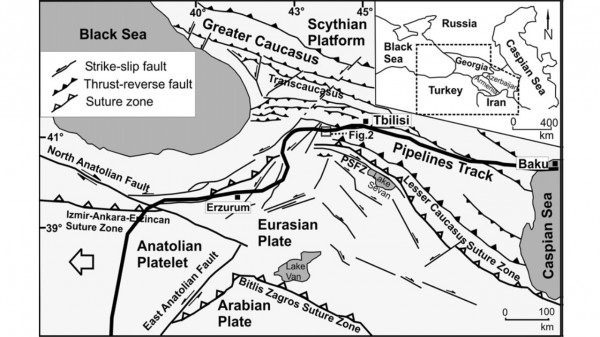About Georgia
The Republic of Georgia and nearby territories of Armenia, eastern Turkey, and northwest Iran represent a seismically active, geologically complex area located in the Alpine-Himalayan fold-thrust belt. From north to south, this area includes the following structural domains: The Greater Caucasus, the Transcaucasus, the Lesser Caucasus suture zone, the Izmir-Ankara-Erzincan suture zone, the east Anatolian microplate, the Bitlis-Zagros suture zone, and the Arabian plate. The formation of this complex domain is related to the convergence and continental collision between the Arabian and Eurasian plates; some studies suggest that this continental collision began as recently as 10 Ma.  The collision resulted in the lateral ejection of the Anatolian block westward and the Iranian block eastward Along with this process of lateral extrusion there has been the compression of the region placed between the northern tip of the Arabian plate to the south and the Eurasian plate to the north.
The collision resulted in the lateral ejection of the Anatolian block westward and the Iranian block eastward Along with this process of lateral extrusion there has been the compression of the region placed between the northern tip of the Arabian plate to the south and the Eurasian plate to the north.
A few studies based on the estimated sum of the seismic moment of earthquakes yielded an average value of 1.3 mm/year shortening rate in this sector of the Alpine belt. In comparison with the Arabian-Eurasian convergence rate (estimated at 20-30 mm/year), it can be suggested that 80-90% of the deformation is a seismic.
One of the characteristics of the Caucasian region is the complexity of its present-day tectonic setting, dominated by an association of both compressive E-W striking thrusts and folds and N-S directed normal faults and dykes, accompanied by Neogene to Quaternary volcanism. Moreover, there are also NE-SW left-lateral and NW-SE right-lateral strike-slip faults.

